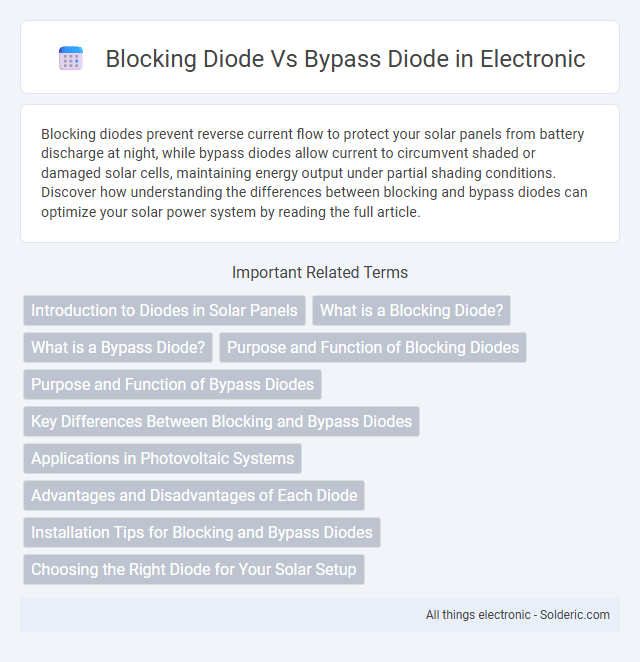Blocking diodes prevent reverse current flow to protect your solar panels from battery discharge at night, while bypass diodes allow current to circumvent shaded or damaged solar cells, maintaining energy output under partial shading conditions. Discover how understanding the differences between blocking and bypass diodes can optimize your solar power system by reading the full article.
Comparison Table
| Feature | Blocking Diode | Bypass Diode |
|---|---|---|
| Purpose | Prevents reverse current from draining the battery or power source. | Protects solar panels from hotspot damage by bypassing shaded or faulty cells. |
| Location | Placed in series with the power source and load. | Connected in parallel with solar panel cells or modules. |
| Function | Blocks reverse current flow to avoid battery discharge. | Allows current to bypass shaded or damaged cells to maintain system output. |
| Application | Used in solar panel systems to prevent battery discharge at night. | Used inside solar panels or arrays to prevent power loss and damage. |
| Effect on System | Increases system efficiency by stopping power loss due to reverse flow. | Protects module integrity, improving overall longevity and performance. |
| Typical Device | Schottky or silicon diode with low forward voltage drop. | Silicon diode rated for high current and voltage. |
Introduction to Diodes in Solar Panels
Diodes in solar panels serve critical roles in protecting and optimizing energy flow. Blocking diodes prevent reverse current from draining the battery at night, ensuring your solar system maintains energy efficiency. Bypass diodes minimize power loss by allowing current to flow around shaded or damaged cells, enhancing overall panel performance.
What is a Blocking Diode?
A blocking diode is a semiconductor device used in solar power systems to prevent reverse current flow from batteries to solar panels, protecting the panels from damage during low sunlight conditions. It allows current to flow only in one direction, ensuring that your solar array maintains efficiency by preventing power loss. Unlike bypass diodes, blocking diodes are primarily focused on blocking reverse currents rather than bypassing shaded or faulty cells in a solar panel string.
What is a Bypass Diode?
A bypass diode is a semiconductor device connected in parallel with solar panels to protect them from the effects of shading and hot spots by allowing current to bypass the shaded cells. It prevents power loss and potential damage by maintaining current flow through the unshaded sections of the panel. Unlike blocking diodes, which stop reverse current flow in the entire array, bypass diodes specifically minimize the impact of partially shaded cells within a solar module.
Purpose and Function of Blocking Diodes
Blocking diodes prevent reverse current flow from a battery or load back into the solar panel, protecting the system from potential damage and power loss. Their primary function is to ensure that electricity flows in only one direction, safeguarding your solar setup during low light conditions or when panels are shaded. Unlike bypass diodes, which protect individual cells from overheating by redirecting current around shaded sections, blocking diodes focus on maintaining overall system efficiency and battery safety.
Purpose and Function of Bypass Diodes
Bypass diodes protect solar panels from hot spots by allowing current to flow around damaged or shaded cells, maintaining overall energy output and preventing panel damage. Their function is to provide an alternate path for current during partial shading, ensuring consistent voltage and reducing power loss. Unlike blocking diodes, which prevent reverse current flow into the solar array, bypass diodes improve panel efficiency under non-ideal lighting conditions.
Key Differences Between Blocking and Bypass Diodes
Blocking diodes prevent reverse current flow from the battery to the solar panel during low or no sunlight conditions, protecting the system from power loss. Bypass diodes, on the other hand, are installed parallel to solar cells or modules to allow current to bypass shaded or damaged cells, minimizing power drop and hot spots. Blocking diodes primarily guard against reverse current, while bypass diodes focus on maintaining module performance under partial shading.
Applications in Photovoltaic Systems
Blocking diodes are primarily used in photovoltaic systems to prevent reverse current flow from the battery to the solar panels during low sunlight conditions, thereby protecting the panels from discharging. Bypass diodes are installed across individual solar cells or panels to maintain power output by allowing current to pass around shaded or damaged cells, reducing hot spots and preventing power loss. Your photovoltaic system's efficiency and longevity significantly benefit from the strategic use of both blocking and bypass diodes in their respective roles.
Advantages and Disadvantages of Each Diode
Blocking diodes prevent reverse current flow, protecting solar panels from battery discharge but introduce voltage drops causing power loss and heat generation. Bypass diodes enable current to bypass shaded or damaged solar cells, reducing power loss and hot spots but add complexity and cost to the solar panel system. While blocking diodes improve system protection, bypass diodes enhance overall efficiency and panel longevity during partial shading conditions.
Installation Tips for Blocking and Bypass Diodes
For effective installation of blocking diodes, ensure correct polarity by connecting the diode's anode to the solar panel's positive terminal and the cathode to the charge controller to prevent reverse current flow. Bypass diodes should be placed parallel to solar cells within the panel, soldered with minimal lead length to reduce voltage drop and heat buildup, enhancing panel performance during shading. Use heat sinks or thermal adhesive to manage diode temperature and prevent damage, and always test connections with a multimeter to verify proper functionality.
Choosing the Right Diode for Your Solar Setup
Selecting the right diode for your solar setup hinges on understanding the differences between blocking and bypass diodes. Blocking diodes prevent current from flowing backward into the panels during low-light conditions, protecting your battery and system efficiency. Bypass diodes, embedded within solar panels, minimize power loss by redirecting current around shaded or damaged cells, ensuring optimal energy output.
Blocking diode vs bypass diode Infographic

 solderic.com
solderic.com